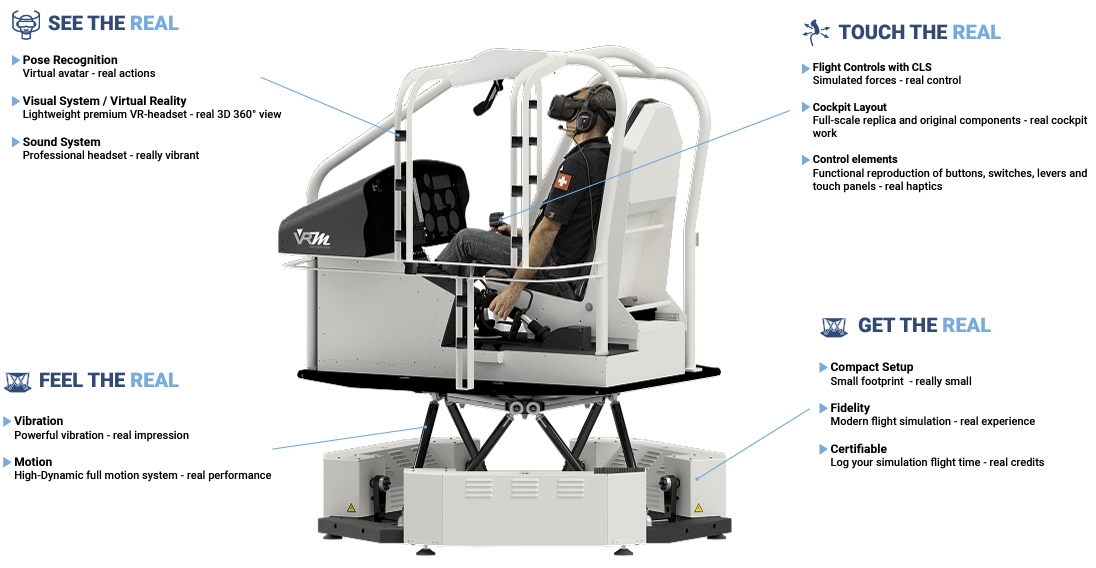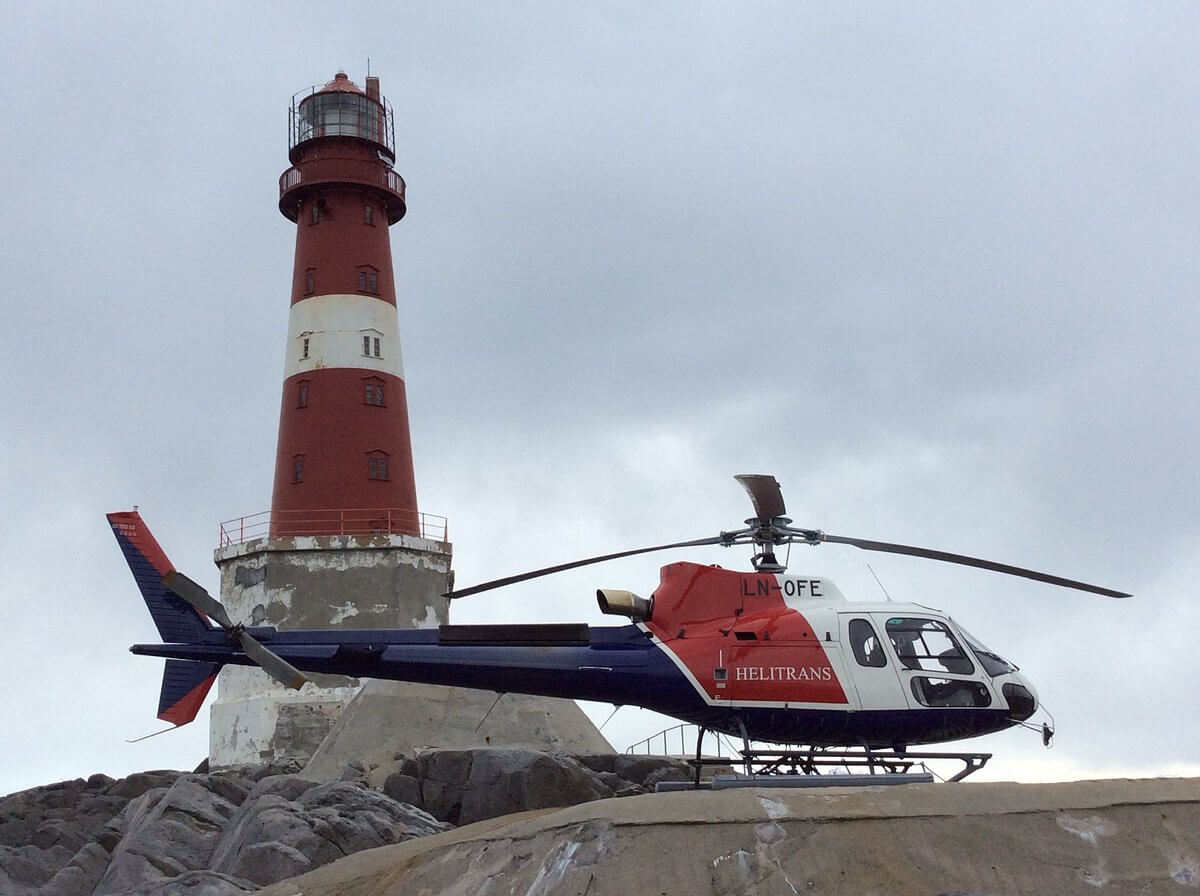AS 350 VR Helicopter Simulator
AS 350 VR Helicopter Simulator
World's First VR AS350 EASA Approved Simulator
Our numerical simulation software and the virtual reality view allow the pilot to fly manoeuvres like in a real helicopter.
The motion system, a vibration actuator, and the sound system result in perfect full-body immersion. Simulated wind, turbulence, and reduced visibility are challenges even for experienced pilots.
Frequently Asked Questions
One simulator is located at Gardermoen Oslo Airport. Here we have placed the simulator in the CAE simulator center.
The second simulator is located in Trondheim at Værnes Airport.
Both simulators are in the immediate vicinity of both the airport and hotels, so that they are easily accessible to our customers.
Yes, you can. We can train your instructors, TRI, TRE and check them out to be able to use this simulator.
You can then rent the simulator to train your own pilots.
Yes, all international customers are welcome to train in our facilities.
Yes, both simulators have hotels within walking distance from the airport to the hotel and from the hotel to the simulator.
Yes, both simulators are EASA approved for LPC/OPC and deliver the best technology within VR technology.
Instructors with Worldwide Experience
- Overview
- Course Details
- Technical Information
- Pricing
- Course Start
Overview
The H125 FSTD represents state of the art VR simulators with incredible graphics and realism. No other H125 simulator gives a 360-degree field of view with the ability to train advanced operations and situations with such realism.
The H125 FSTD represents an Airbus AS350 B3e (H125), which is the most common single-turbine helicopter in its class. The simulator was optimized in cooperation with experts from Airbus Helicopters to provide the pilot with the most realistic flight experience and training effect to enhance flight safety.

From the familiarization to a turbine helicopter to demanding scenario-based training, mountain flying, and emergency exercises, simulation is tailored to the needs of the trainee.
The cockpit is fully functional, and the controls have force feedback to simulate hydraulic system failures or other effects that result in a change of control forces. Together with the high dynamic motion platform, a 3D VR visual system, and a sound system, the pilot dives into a full body immersion.
International Focus – We have over 30 nationalities performing training with us
Residential Courses – Our campus offers student accommodation in the vicinity of the training center
Focus On People – Flexible and customizable training
Student Dedication – High instructor to student ratio
Career Opportunities – Scandinavian Aerospace Academy is collaborating with airlines
Course Details
Basic manoeuvres and skills
- Hover
- Approaches
- Autorotation
- Slope operations
- Confined area operation
- Instrument flying and radio navigation
- Emergency procedures
- Tail rotor transmission failure
Advanced training manoeuvres and competencies
- Advanced training for commercial pilots
- HESLO-training
- Emergency procedures
Technical Information
The seat is an exact replica of the original. It consists of original or full-scale replica seat cushions and 4-point harnesses for rotorcraft. On the H125 model, the seat position is manually adjustable in the longitudinal direction. High-quality materials promise comfort and durability.
The flight controls are the most interactive elements in the simulator and enable the pilot to fly the helicopter accurately. By integrating original parts or true-to-scale replicas of the cyclic, collective, and pedals, the experience feels very authentic.
The Advanced Control Loading System (CLS) gives the pilot force feedback. It provides a flexible framework for the simulation of aircraft control characteristics.
The control behaviour of the flight controls is calibrated and validated using the flight data package. Precise position sensors are used to transfer the real positions of the controls into VR.
Motion cueing is achieved by an electrical, highly dynamic 6 DoF motion system driven by powerful, state-of-the-art industrial motors and controllers driven by highly dynamic control algorithms. This allows the pilot to feel the slightest movement. The cost-effective system design maximizes availability and minimizes maintenance costs due to its lightweight structure and compact design.
It is developed and produced by VRM Switzerland and is characterized by real-time system monitoring, high diagnostic coverage, and redundant sensor technology.
The vibration system is designed with a resonance body to reproduce the typical frequencies that occur in helicopters. While motion cueing is based on the human perception model for optimum motion perception, the vibration cueing system reproduces the original vibration characteristics.
Course Start
To book your slot click here https://vrsimulator.no/booking-if/
Note: We offer our programs throughout the year to help aspiring pilots reach their goals, kindly connect with us for your requirement.
Tomorrows Airline Captains
Airline Transport Pilot- Program, takes you from zero experience and no previous training, all the way to a fully trained Airline Pilot with the necessary Commercial Pilot License and Multi-Crew courses. Scandinavian Aerospace Academy provides the training in Scandinavian weather which will give you an unforgettable experience. We have chosen the modular method for the ATP-Program and the reason is simple, we do not believe in shortcuts and less training! Modular training in a controlled environment combined with industry experience is the perfect match and optimum training a student pilot can receive. Come and visit us and we’ll tell you more about our training philosophy.
Our instructors are highly qualified and experienced airline pilots. We have one of the highest percentages of airline experience divided amongst our instructors. This is a key factor for ensuring that our programs are up to date, meeting standards and requirements in a changing aviation industry.
Why Sweden and Scandinavian Aerospace Academy for your training?
Scandinavia, Sweden, is the perfect environment to get the experience you need to become a good Pilot. You will experience hot summers as well as winter operations with low visibility. The weather in Sweden requires prospective pilots to be on their best every time they take flight. Scandinavian weather is often described grey and cold, however for future pilots and training, the climate is exceptional. We strongly believe that the better and more challenging your circumstances are during training prepares you for unforeseen situations that you may encounter as an Airline Pilot on the global market.
International Focus – We have over 30 nationalities performing training with us
Residential Courses – Our campus offers student accommodation in the vicinity of the training center
Focus On People – Flexible and customizable training
Student Dedication – High instructor to student ratio
Career Opportunities – Scandinavian Aerospace Academy is collaborating with airlines
Scandinavian Aerospace Academy is built on a simple principle, for pilots, by pilots. Management is built and led by active industry professionals always striving for a safer and broader perspective when it comes to aviation training. Are you ready for the next step?
COURSE DETAILS
The ATP program consists of several course that can be found in detail under timeline below.
Initially the program starts with PPL theory and flight training. Upon passing examinations and skilltest the students obtain an PPL-license and collect hours in command. The students then move on to the commercial part of aviation, starting with the ATPL-Theory, a 9 month long course covering various courses. Upon reaching sufficient amount of flight hours and passing all the ATPL examinations, the students enter the Multi Engine (ME), Commericial Pilot License (CPL) and Instrument Rating (IR) phase.
Upon passing the CPL ME/IR skilltest the students move on to the final phase Multi Crew Cooperation (MCC).
All training is conducted in Piper PA28, Diamond DA42, DA42 Simulator and Boeing 737 Simulator.
Timeline
Below is a table showing the different phases of training and duration expected to complete each phase.
| Phase | Timeframe |
|---|---|
| Private Pilot License (PPL) | 6 months |
| ATPL-theory | 9 months |
| Night Rating | 2 weeks |
| Hour building / PIC training | 3,5 months |
| Class Rating MEPL | 3 weeks |
| Commercial Pilot License (CPL) | 1,5 months |
| Instrument Rating | 2 months |
| Multi Crew Co-operation (MCC) | 3 weeks |
| Total estimated | 24,0 months (2 years) |
PRE-ENTRY REQUIREMENTS
In order to be eligible for the Airline Transport Pilot (ATP) Program you need to fulfill all the requirements listed below:
Medical Certificate : Valid Medical Class 1 is required prior to starting your training. Medical Class 1 will be accepted from any EASA country. Do you need more information about obtaining an EASA Medical Class 1? Contact us.
License and Ratings : No previous license or ratings are required prior to starting the ATP-Program.
Language Proficiency : In order to issue an EASA CPL license you will need to obtain a language proficiency level which follows the ICAO standard. The minimum level required to start your training is English level 4 (4 out of 6). This will be assessed during your pre-entry assessment.
The pre-entry requirements are necessary in order for you to start your training at Scandinavian Aerospace Academy. If you have any questions about the requirements, don’t hesitate to contact us and we will answer all your questions.
PRICING
All prices for this course are listed below and split into different packages in order to offer a flexible solution that suits your needs.
* If you’re residing outside of the European Union (EU) you will require a student visa to Sweden, this can be administrated by us and for this service we charge 2500 EUR.
* Pre-entry assessment will be charged 750 EUR if you decide not to start the ATP-Program.
The prices listed above are the only fees associated with your training, what you see is what you get, simple as that. We don’t have any hidden fees or extra costs that will be added during the course, you pay for your training as you get it.
Financial Options
Financial student loans are available for Swedish citizens and can be arranged through our partnerships with Swedish banks.
Build Your Future With Scandinavian Aerospace Academy
Pilot training is an expensive investment, we know that since most of the staff in our organization has at some point, experienced the same journey. Therefore we understand the investment you are about to make and we respect that investment. Our goal is to deliver the best possible training at a reasonable cost.
Our staff is here to assist you with any questions you may have, feel free to contact us at training@flyscan.academy with your questions.
COURSE START
The next available course start for the ATP-Program can be found below,
- February 27th 2023
- April 24th 2023
The final date to apply is one month prior to the course start, however we recommend that you apply earlier to secure your slot. If you’re requiring a visa for your studies, the recommendation is to apply three months prior to the course start.




